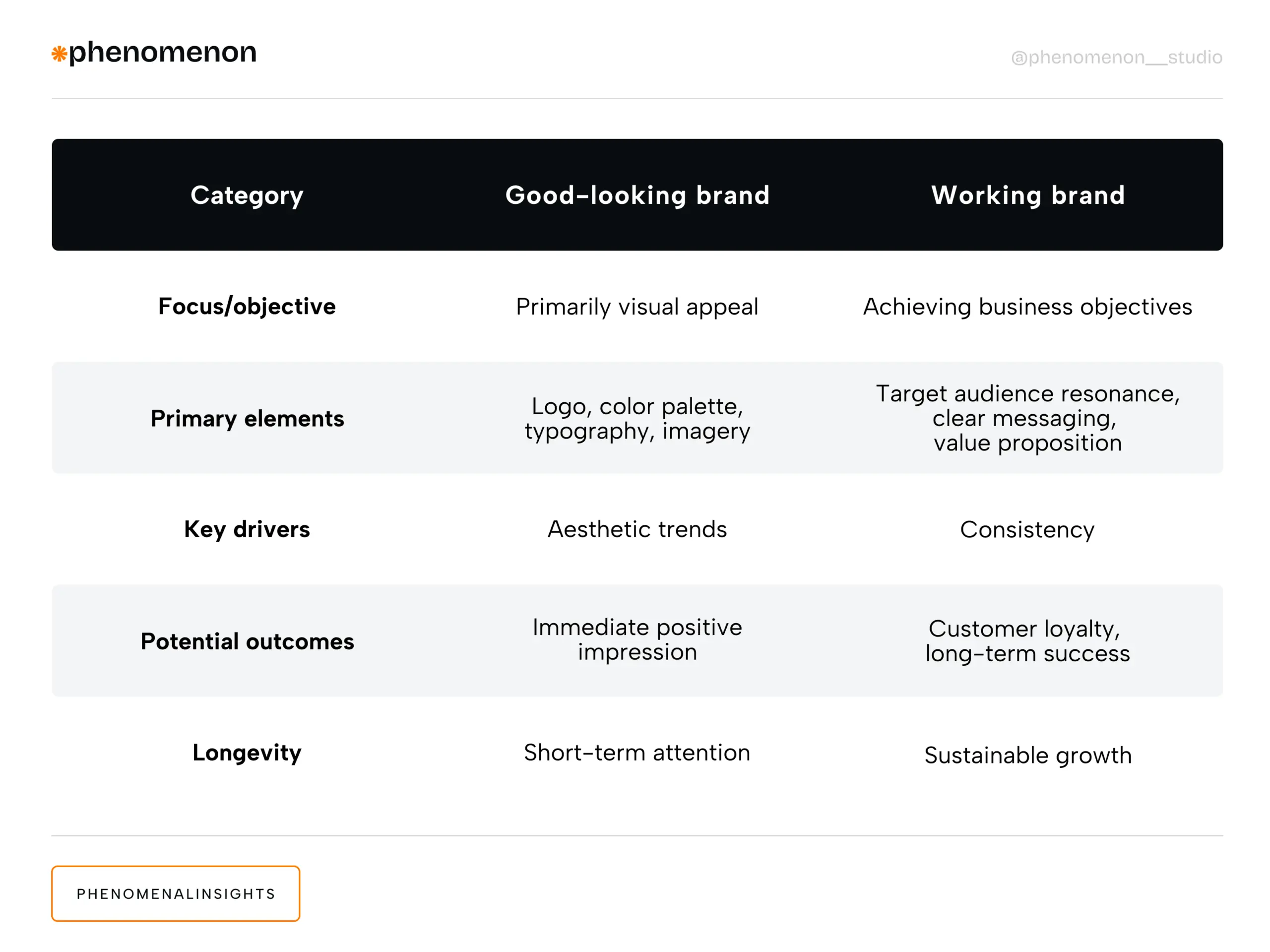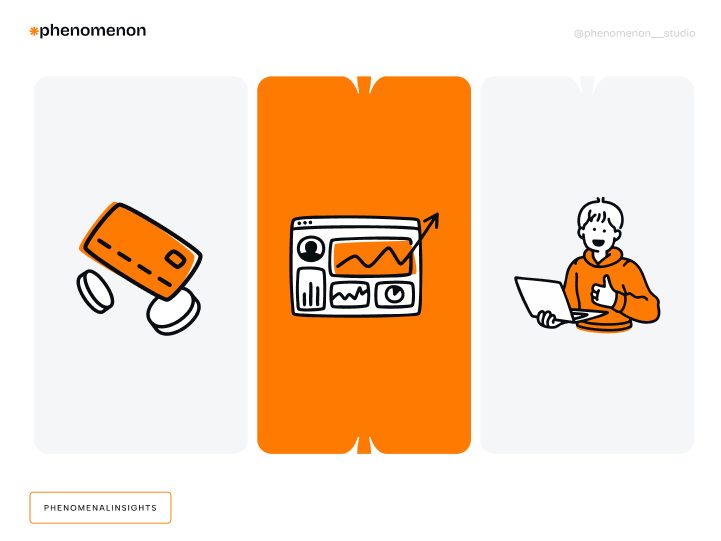What makes a brand successful? Is it the logo design, the Instagram grid, the bold color palette that turns heads? While these visual elements get attention first, they are only part of the equation.
What makes a brand successful? Is it the logo design, the Instagram grid, the bold color palette that turns heads? While these visual elements get attention first, they are only part of the equation. Logos are a foundational component of brand identity design, contributing significantly to audience perception and emotional connection. They serve as visual representations of a brand and are central to the overall branding strategy, influencing how memorable and recognizable a brand becomes in a competitive landscape. A brand’s effectiveness is more than just looking good. It’s about aligning visual with strategy to get results.
This blog explores the difference between a good looking brand and a working brand. You’ll learn what it takes to build a brand that doesn’t just look good but makes an impact on your business. From defining the foundation of a brand to practical steps to ensure strategy alignment, this guide is for CEOs, founders, CMOs and business owners to get long term results.
What is a Brand? Identity First
To understand what makes a good-looking brand and a working brand, you need to define the core pillar of branding: brand identity.
Brand Identity
Brand identity includes the visual and symbolic elements that represent your business — your logo, color palette, typography, imagery, and the overall look and feel. Together these elements create an emotional connection with your audience and make your brand recognizable.
A helpful framework for creating an appealing brand identity is the ‘seven elements,’ essential for building a successful brand that resonates with its audience.
Key elements of brand identity:
-
Logo: A unique symbol or wordmark that represents your brand’s essence.
-
Color Palette: Carefully chosen colors that evoke emotions and associations.
-
Typography: The fonts and styles that express your brand’s tone.
-
Imagery and Graphics: Photos, illustrations, and graphics that support your message.
-
Consistency: Uniform application of all visual elements across channels to build recognition.
Breaking Down the Good-Looking Brand
A good-looking brand is beautiful. It gets attention with polished visuals and trendy designs. But it’s often superficial, prioritizing style over deeper intent.
Product packaging plays a crucial role in a brand’s visual representation, serving as a key element in the brand style guide and contributing to a cohesive image that resonates with consumers.
Characteristics of a Good-Looking Brand
-
Stunning Visuals: Visually impressive, with a focus on current design trends.
-
Eye-Catching Logo: Memorable and aesthetically pleasing, but not always meaningful.
-
Trendy Color Schemes: Chosen for wow factor rather than long-term consistency or audience relevance.
-
Elegant Typography: Fashionable fonts that may not communicate the brand’s tone.
-
Photogenic Content: Instagram-ready but possibly lacking relevance or depth.
The Pitfalls of an Aesthetic-First Approach
-
Lack of Substance: Without a clear identity, your brand may not effectively communicate unique values or offerings.
-
Missed Target Audience: Designing for aesthetic appeal rather than user needs risks alienating customers.
-
Reliance on Trends: Following short-lived trends can make your brand feel outdated quickly.
What Makes a Working Brand?

A working brand prioritizes effectiveness over aesthetics. This doesn’t mean neglecting visual appeal but ensuring every visual decision supports a larger strategic framework.
Characteristics of a Working Brand
- Customer Centric Design
A working brand knows its audience and creates brand elements that resonate with them emotionally and functionally. These brand elements, including design choices and guidelines, help maintain consistency across various channels and ensure that the brand resonates with its target audience. For example, a brand targeting sustainability-conscious customers might use earthy tones and minimal design to reflect those values.
- Clear Messaging
Every element of communication is deliberate and aligned with the brand’s purpose. A powerful tagline, concise marketing copy and consistent voice helps communicate the brand’s promises.
- Defined Value Proposition
A working brand shows how it solves customers problems or improves their lives. Simplified messaging ensures customers get it instantly.
- Performance Driven Approach
A working brand is measured by tangible outcomes like sales, customer loyalty and positive brand sentiment.
- Consistency Across Touchpoints
From website design to in-store experiences a working brand delivers a cohesive experience for customers, building trust and credibility.
Examples of Working Brands
- Nike balances bold visuals with emotional messaging (“Just Do It”) and customer first focus. Successful brands like Nike invest effort into creating a holistic identity that encompasses strong purpose and cohesive visual and written elements.
- Apple uses clean design and strategic branding to show its commitment to innovation and user friendly technology. Successful brands like Apple exemplify how a comprehensive approach to brand identity design can lead to a strong market presence.
How Purpose Drives Visual Identity
How do you build a brand that looks good and works? The answer is to let purpose guide your visual identity.
Understanding color theory, customer psychology, and how each design decision reflects your values is key to building something meaningful.
Steps to Align Visuals with Goals
-
Define Your Brand Purpose
Know why your brand exists and what makes it unique. Let this purpose inspire your visuals. -
Understand Your Audience
Conduct market research to discover what your audience finds compelling. -
Prioritize Consistency
Ensure your visuals, tone, and customer experience are cohesive across all platforms. A brand guide helps maintain this consistency. -
Audit Competitors
Learn from others — identify strengths and gaps to position your brand effectively.
Visual identity isn’t just decoration. It’s a strategic tool to connect with your audience and communicate your value.

Brand Communication and Voice
Brand communication and voice are essential components of a brand’s identity. A brand’s voice refers to the tone and language used in its marketing materials and customer interactions. A well-defined brand voice helps to create a consistent brand image and builds trust with the target audience. Whether it’s through social media posts, email marketing, or customer service interactions, every touchpoint should reflect the brand’s personality and values.
Effective brand communication and voice can help to build a memorable brand identity and differentiate a brand from its competitors. By aligning your brand’s voice with its personality and values, you create a cohesive brand experience that resonates with your audience. This consistency not only enhances customer loyalty but also drives business growth. Remember, a strong brand voice is critical for creating a lasting impression and fostering a deep connection with your customers.
Brand Guidelines and Consistency
Brand guidelines are a set of rules that outline how a brand’s identity should be used across all marketing materials and customer interactions. Consistency is key to creating a strong brand identity, and brand guidelines help to ensure that all elements of the brand are used correctly. These guidelines should cover the brand’s visual identity, including the logo, color palette, and typography, as well as the brand’s voice and tone.
Consistent use of a brand’s identity elements helps to create a recognizable and memorable brand image. Brand guidelines should be easily accessible to all employees and partners to ensure that the brand is represented consistently across all channels. Regularly reviewing and updating these guidelines is essential to ensure they remain relevant and effective. By adhering to well-defined brand guidelines, you can create a cohesive and strong brand identity that stands out in the market.
Measuring a Brand’s Success
How do you know if your brand is working? Metrics matter.
Key takeaways regarding brand identity and its components include the importance of establishing clarity, consistency, and resonance with your target market, which contributes to a brand’s unique presence in a competitive landscape.
Key Performance Indicators (KPIs) to Track
- Brand Awareness: Survey recognition levels among your target audience.
- Customer Loyalty: Measure retention rates and repeat purchases.
- Engagement: Track likes, shares and comments on social platforms.
- Sales Performance: Analyze how branding impacts overall revenue.
- Net Promoter Score (NPS): Monitor how likely customers are to recommend your brand.
- Brand Management: Utilize brand management to systematically measure and analyze audience perceptions of your brand.
Protecting the Brand’s Identity
Protecting a brand’s identity is crucial for maintaining its value and reputation. A brand’s identity is a valuable asset that should be safeguarded against misuse or misrepresentation. Registering a brand’s trademarks, such as its logo and name, helps to prevent unauthorized use. Monitoring social media and online platforms for unauthorized use of a brand’s identity is also essential.
Having a clear brand guidelines document helps to ensure that all employees and partners understand how to use the brand’s identity correctly. Regularly reviewing and updating these guidelines and policies helps to prevent identity misuse. Protecting a brand’s identity requires ongoing effort and attention to maintain its value and reputation. By taking proactive measures, you can safeguard your brand’s identity and ensure its long-term success.
Creating a Positive Brand Image
Creating a positive brand image is essential for building customer loyalty and driving business growth. A brand’s image is influenced by all aspects of its identity, including its visual elements, voice, and personality. Consistency is key to creating a positive brand image, and all elements of the brand should be aligned with its values and personality.
A brand’s image can be enhanced by creating engaging and relevant content that resonates with its target audience. Providing excellent customer service and building strong relationships with customers helps to create a positive brand image. Additionally, a brand’s image can be influenced by its social responsibility and community involvement. Regularly monitoring and evaluating a brand’s image helps to identify areas for improvement and ensure that it remains positive and relevant. By focusing on these aspects, you can create a strong and positive brand image that attracts and retains customers.
Brand Evolution and Adaptation
A brand’s identity should evolve and adapt over time to remain relevant and effective. Changes in the market, technology, and customer needs can all impact a brand’s identity and require adjustments. A brand’s evolution should be guided by its core values and personality to ensure that it remains true to its roots.
Adaptation can involve updates to a brand’s visual identity, such as its logo or color palette. It can also involve changes to a brand’s voice and tone, as well as its marketing strategies and tactics. Regularly reviewing and evaluating a brand’s identity and performance helps to identify areas for evolution and adaptation. A brand’s ability to evolve and adapt is critical for its long-term success and survival in a rapidly changing market. By staying flexible and responsive, you can ensure your brand remains relevant and continues to thrive.
Building a Balanced Brand
A memorable logo or stylish Instagram aesthetic may get attention but it’s only half the equation. Long term success requires a brand identity that is created to align with a solid strategy. By prioritizing both form and function you can create a brand that looks good and delivers.
Ready to build a brand that works as hard as you do? Consider conducting a brand audit or consulting with a branding expert to refine your approach and maximize impact.













